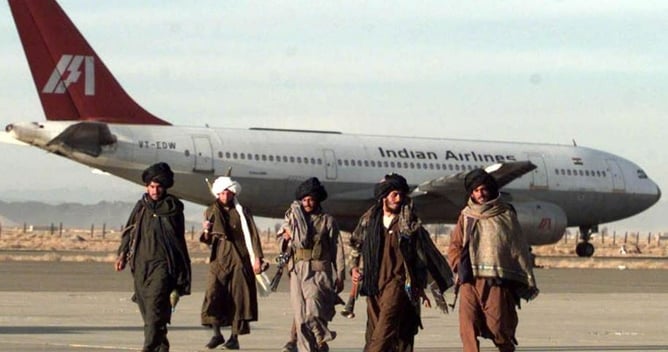

A Nation Hijacked
December 24, 1999 — as most Indians prepared to celebrate Christmas and the dawn of a new millennium, a passenger aircraft carrying 176 souls on board was seized mid-air by masked terrorists. The week-long ordeal that followed was not just a hijacking; it was a profound moment of reckoning for Indian diplomacy, intelligence, and national resolve. The hijacking of Indian Airlines Flight IC 814 to Kandahar by Pakistani-backed terrorists not only exposed India's vulnerabilities but also unleashed a cascade of terrorist violence that reverberates to this day.
This is the story of IC 814 — a story of courage, tragedy, political compromise, and the birth of a new chapter in global jihadism.
The Flight That Never Reached Its Destination
Flight IC 814 was a routine Indian Airlines service that departed from Tribhuvan International Airport in Kathmandu, Nepal, on December 24, 1999, at 4:30 PM IST, heading to Indira Gandhi International Airport in New Delhi. Onboard were 176 people — 150 passengers, 15 crew members, and a sense of safety that would soon be shattered.
Approximately 40 minutes into the flight, as the aircraft entered Indian airspace over Lucknow, India, five armed men stormed the cockpit. Armed with knives, grenades, and reportedly pistols, they commandeered the Airbus A300, redirecting it first towards Lahore, Pakistan, which denied landing permission, then Amritsar, where Indian authorities failed to act decisively. The plane eventually refueled in Lahore, flew to Dubai (where 27 hostages including women and children were released), and finally landed in Taliban-controlled Kandahar, Afghanistan — then a lawless hub of Islamist extremism.
Detailed Timeline of Events
Dec 24, 1999, 4:30 PM IST: IC 814 departs Kathmandu.
~5:05 PM: Hijackers seize the cockpit over Lucknow.
5:30 PM: Flight diverted to Lahore, denied landing.
6:00 PM: Flies to Amritsar, hovers for 45 minutes. Indian authorities hesitate.
7:00 PM: Leaves Indian airspace, heads to Lahore.
8:00 PM: Lands in Lahore, refuels.
Late Night: Flies to Dubai, lands around 2:30 AM on Dec 25.
Dec 25, 1999: 27 hostages, including women and children, are released in Dubai.
Dec 25, ~6:00 PM: Flight takes off for Kandahar.
Dec 25-31: Aircraft grounded in Kandahar, hijackers fortify control with Taliban help.
Dec 27: Terrorists stab passenger Rupin Katyal to death.
Dec 29-30: Negotiations intensify. India agrees to release three terrorists.
Dec 31: Foreign Minister Jaswant Singh escorts the terrorists to Kandahar. Hostages are released.
Jan 1, 2000: IC 814 returns to India. The hijackers escape with Taliban support.
Who Were the Hijackers?
The five hijackers were later identified as members of the Pakistan-based Islamist militant outfit Harkat-ul-Mujahideen (HuM). They went by the aliases:
Ibrahim Athar (brother of terrorist Masood Azhar)
Shahid Akhtar Sayed
Sunny Ahmed Qazi
Zahoor Mistry
Shakir (alias Abdul Rauf, brother of terrorist Masood Azhar)
Their motive was simple: the release of three prominent Pakistani terrorists held in Indian custody. Their names would soon become infamous:
1. Masood Azhar – Founder of Jaish-e-Mohammed (JeM), an ideologue with deep connections to Al-Qaeda and the Taliban.
2. Ahmed Omar Saeed Sheikh – A British-born terrorist, later involved in the 2002 kidnapping and murder of Wall Street Journal journalist Daniel Pearl.
3. Mushtaq Ahmed Zargar – A Kashmiri militant and commander of Al-Umar Mujahideen, responsible for violent insurgency in the Kashmir Valley.
Negotiators and Decision-Makers
The crisis was handled by:
Ajit Doval (then Joint Director, Intelligence Bureau, India) – Operated behind the scenes in Afghanistan.
Jaswant Singh (External Affairs Minister, India) – Public face of negotiations.
Brajesh Mishra (National Security Advisor)
Ravindra Singh (Joint Secretary, Ministry of External Affairs, India)
Taliban interlocutors served as intermediaries.
The Kandahar Deadlock: India's Negotiation Nightmare
The aircraft remained grounded in Kandahar for seven days. With each passing hour, the anxiety of the nation intensified. The hijackers, communicating through intermediaries, demanded the release of the aforementioned trio along with a ransom in U.S. dollars and the reburial of deceased HuM militants.
India faced a near-impossible task. The Taliban, which officially denied any alliance with the hijackers, stationed armed fighters around the aircraft under the guise of "protection." This gave the terrorists effective immunity from Indian special forces action. Inside the aircraft, passengers suffered inhumane conditions — deprived of adequate food, water, and medicine.
On the fifth day, the hijackers stabbed a passenger — Rupin Katyal — to death. His mutilated body was returned as a macabre message. The killing escalated pressure on Indian authorities to act.
The Political Decision: Release and Return
Facing mounting pressure, India agreed to release Masood Azhar, Omar Sheikh, and Mushtaq Zargar. On December 31, Jaswant Singh personally escorted them to Kandahar. The hostages were released. The hijackers fled under Taliban protection.
Aftermath: The Terror Unleashed
1. Masood Azhar and the Formation of Jaish-e-Mohammed
Soon after his release, Azhar founded Jaish-e-Mohammed (JeM) — a terrorist organization with deep ties to Pakistan's Inter-Services Intelligence (ISI). JeM carried out some of the most lethal attacks on Indian soil:
2001 Indian Parliament Attack – On December 13, 2001, JeM and Lashkar-e-Taiba operatives stormed Parliament, killing nine and bringing India and Pakistan to the brink of war.
2005 Ayodhya Attack
2008 Jammu and Kashmir bombings, and others
2016 Pathankot Airbase Attack
2019 Pulwama Suicide Bombing – Claimed by JeM, resulting in 40 CRPF jawans killed
Masood Azhar became the face of cross-border terrorism, a UN-designated global terrorist in 2019 — after China lifted its veto under international pressure.
2. Ahmed Omar Saeed Sheikh: Global Terror Architect
Omar Sheikh moved beyond Kashmir, forging ties with Al-Qaeda and ISI. His most heinous act was orchestrating the 2002 beheading of journalist Daniel Pearl in Karachi. He was also reportedly linked to financing one of the 9/11 hijackers.
He was sentenced to death in Pakistan, but the conviction was overturned in 2020 — a move that drew global outrage and once again highlighted Pakistan’s duplicity on terrorism.
3. Mushtaq Ahmed Zargar: The Kashmir Menace
Zargar returned to foment militancy in Kashmir. He resumed his role in Al-Umar Mujahideen, spreading violence, recruiting fighters, and coordinating attacks. Although less globally infamous than Azhar and Sheikh, Zargar’s footprint remained active in fomenting insurgency.
Justice, Delayed but Delivered: Operation SINDOOR
In April 2025, India conducted Operation SINDOOR, a high-precision cross-border strike that eliminated Abdul Rauf Azhar (Shakir), one of the five original hijackers and a top commander in JeM. His death serves as partial retribution for the IC 814 hijacking, marking a culmination of India’s 25-year-long pursuit of justice.
Conclusion: A Turning Point in India’s Modern History
The hijacking of IC 814 was a brutal awakening for India. It reshaped national security policy, deepened public consciousness about cross-border terrorism, and paved the way for future assertive responses. The subsequent violence perpetrated by the released terrorists proved that appeasement comes at a high price. And yet, the long arc of justice, as seen in the elimination of Abdul Rauf Azhar, affirms that India does not forget.
From the blood-stained tarmac of Kandahar to the recent battlefield victories, the story of IC 814 remains a stark reminder that the cost of peace must never be cowardice.
